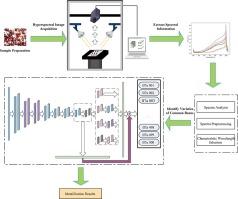基于高光谱和深度学习的普通豆类种子品种识别研究。
IF 4.3
2区 化学
Q1 SPECTROSCOPY
Spectrochimica Acta Part A: Molecular and Biomolecular Spectroscopy
Pub Date : 2024-09-24
DOI:10.1016/j.saa.2024.125212
引用次数: 0
摘要
准确、快速和无损地识别蚕豆种子的品种对于蚕豆的种植和有效利用非常重要。本研究基于高光谱和深度学习技术,对普通豆类种子的品种进行无损识别。在本研究中,经过图像分割和敏感区域提取,得到了来自 500 个品种的 3078 幅高光谱图像的平均光谱,并使用合成少数过采样技术(SMOTE)实现了各品种样本的均衡。提出了一个包含初始模块和残差结构的一维卷积神经网络模型(IResCNN)来识别种子品种,并建立了支持向量机(SVM)、K-近邻(KNN)、VGG19、AlexNet、ResNet50 等模型来比较识别效果。在分析了多种光谱预处理方法对模型的影响后,研究选择了萨维茨基-戈莱平滑校正(SG)进行光谱预处理,并利用连续投影算法(SPA)提取了 66 个特征波长作为判别模型的输入。最终,IResCNN 模型在测试集上取得了 93.06 % 的最高准确率,表明高光谱技术能够准确识别豆类品种,该研究为多品种小样本豆类品种的无损分类提供了正确的思路方法。本文章由计算机程序翻译,如有差异,请以英文原文为准。

Research on variety identification of common bean seeds based on hyperspectral and deep learning
Accurate, fast and non-destructive identification of varieties of common bean seeds is important for the cultivation and efficient utilization of common beans. This study is based on hyperspectral and deep learning to identify the varieties of common bean seeds non-destructively. In this study, the average spectrum of 3078 hyperspectral images from 500 varieties was obtained after image segmentation and sensitive region extraction, and the Synthetic Minority Over-sampling Technique (SMOTE) was used to achieve the equilibrium of the samples of various varieties. A one-dimensional convolutional neural network model (IResCNN) incorporating Inception module and residual structure was proposed to identify seed varieties, and Support Vector Machine (SVM), K-Nearest Neighbor (KNN), VGG19, AlexNet, ResNet50 were established to compare the identification effect. After analyzing the effects of multiple spectral preprocessing methods on the model, the study selected Savitzky-Golay smoothing correction (SG) for spectral preprocessing and extracted 66 characteristic wavelengths using Successive Projections Algorithm (SPA) as inputs to the discriminative model. Ultimately, the IResCNN model achieved the highest accuracy of 93.06 % on the test set, indicating that hyperspectral technology can accurately identify bean varieties, and the study provides a correct method of thinking for the non-destructive classification of multi-species small-sample bean varieties.
求助全文
通过发布文献求助,成功后即可免费获取论文全文。
去求助
来源期刊
CiteScore
8.40
自引率
11.40%
发文量
1364
审稿时长
40 days
期刊介绍:
Spectrochimica Acta, Part A: Molecular and Biomolecular Spectroscopy (SAA) is an interdisciplinary journal which spans from basic to applied aspects of optical spectroscopy in chemistry, medicine, biology, and materials science.
The journal publishes original scientific papers that feature high-quality spectroscopic data and analysis. From the broad range of optical spectroscopies, the emphasis is on electronic, vibrational or rotational spectra of molecules, rather than on spectroscopy based on magnetic moments.
Criteria for publication in SAA are novelty, uniqueness, and outstanding quality. Routine applications of spectroscopic techniques and computational methods are not appropriate.
Topics of particular interest of Spectrochimica Acta Part A include, but are not limited to:
Spectroscopy and dynamics of bioanalytical, biomedical, environmental, and atmospheric sciences,
Novel experimental techniques or instrumentation for molecular spectroscopy,
Novel theoretical and computational methods,
Novel applications in photochemistry and photobiology,
Novel interpretational approaches as well as advances in data analysis based on electronic or vibrational spectroscopy.

 求助内容:
求助内容: 应助结果提醒方式:
应助结果提醒方式:


